 |
||
|
||
| ||
 CONTENTS
The IT experts say that the relationship between ATI and NVIDIA is getting tougher. Yet two years ago ATI Technologies had funds 3 times as small as NVIDIA's ones and buggy products but then it pulled its together. NVIDIA, on the contrary, made some serious mistakes. As a result, both companies are going on a par today. Multiple tests prove that. Who remembers Tseng, Trident, Rendition, PowerVR, S3, 3dfx?.. We have ATI/NVIDIA as venerable manufacturers of 2D/3D accelerators, SIS trying to maintain this sector by flooding it with cheap products which are though not always successful, and Matrox who is on its way out of the 3D market (modern functions do not help slow cards to make a good showing). Unfortunately, the chip makers are diminishing in number. The prices therefore grow up from one High-End generation to another. That's good that both companies remain equal competitors because it actually prevents the takeover. The accelrators' race is very exhausting. ATI and NVIDIA are violently fighting though the demand is getting weaker and the market is shrinking. What's now? Monthly announcements? Who will make the cards? No one sober card maker would do it as he would lose income from the previous solutions. No sooner had the FX 5600 reached the market than the improved NV36 appeared from round the corner. But it's the manufacturers' problem. Not ours. Theoretical materials and reviews of video cards which concern functional
properties of the GPU
NVIDIA's partners have to look for the ways of selling new cards though they may be not that popular. Fortunately for NVIDIA, ATI stumbled over the same stone when laucnhed the RADEON 9600/9600 PRO which was slower than its predecessors. They are quits now, but it makes no difference to users. But prices keep on falling down with time, and sooner or later the 5600 will look more attractive. Plus, fast anisotropy the GF4 Ti could only dream about. Besides, every card maker does his best to think out something original, interesting and attractive. The today's card does have some unique technologies. It's not the first time when AOpen makes its presence felt. We do remember its OpenBIOS, interesting mainboard designing solutions etc. So, meet the AOpen Aeolus GeForce FX 5600S 256MB card. Card
|
||||||||||||||||||||||||||||||||||||||||||||||||||||||||||||||||||||
| AOpen Aeolus GeForce FX 5600S 256MB |  |
|
| AOpen Aeolus GeForce FX 5600S 256MB | |
| AGP x8/x4/x2 interface, 256 MB DDR SDRAM in 8 chips on both PCB sides.
Hynix memory chips of 3.6ns access time, which corresponds to 275 (550) MHz. The memory works at 250 (500) MHz, the GPU runs at 325 MHz. 128bit memory interface. |
 |
| Comparison with the reference design, front view | |
| AOpen Aeolus GeForce FX 5600S 256MB | Reference card NVIDIA GeForce FX 5600 |
 |
 |
 |
|
| Comparison with the reference design, back view | |
| AOpen Aeolus GeForce FX 5600S 256MB | Reference card NVIDIA GeForce FX 5600 |
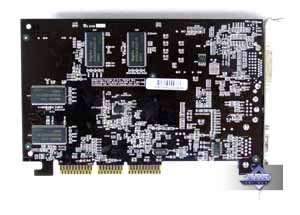 |
 |
| AOpen Aeolus GeForce FX 5600S 256MB | |
| User manual, CD with drivers and utilities, WinDVD, TV extenders, DVI-to-d-Sub, S-Video-to-RCA adapter. | 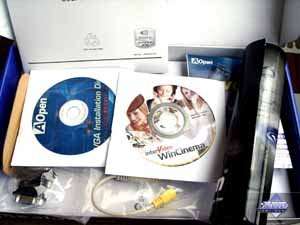 |
| Take a gander at the package: |
| AOpen Aeolus GeForce FX 5600S 256MB | |
| A stylish box in dark colors. The CPU clock is indicated. |  |

Testbed and driversTestbed:
VSync off, S3TC off in applications. Cards for comparison:
Test resultsBefore we start examining 2D quality, I should say there are no complete techniques for objective 2D quality estimation because:
With the ViewSonic P817 monitor and BNC Bargo cable the card showed excellent
quality at the following resolutions and clock speeds: |
| AOpen Aeolus GeForce FX 5600S 256MB | 1600x1200x85Hz, 1280x1024x100Hz, 1024x768x120Hz |
Conventional signs: ANISO 8xP - Anisotropic 8x Performance (earlier it was called Balanced), ANISO 8xQ - Anisotropic 8x Quality, ANISO 16xQ - Anisotropic 16x Quality.
Test applications:

It was expected that the card would perform such way as compared to the 128MB FX 5600 card coming with the faster memory, as well as that it would beat ATI's solutions.
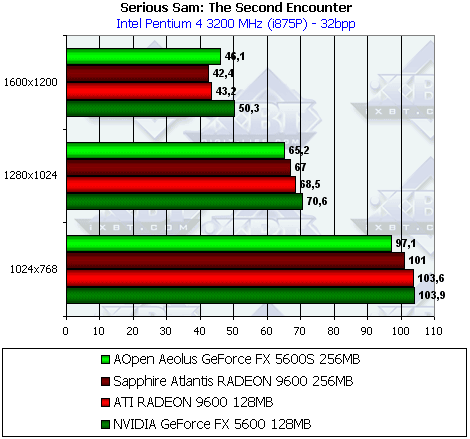
Here the RADEON 9600 takes the lead, and only in 1600x1200 (when the speeds are not playable at all) the FX 5600 outsores it.

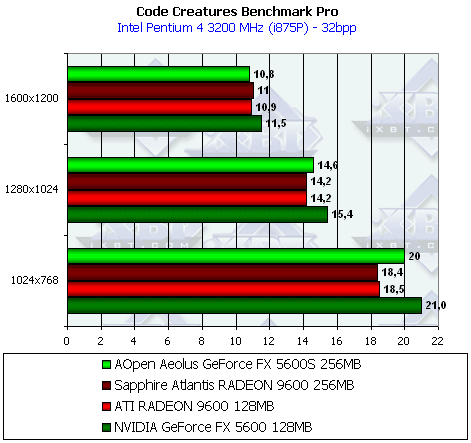
Now the FX 5600 leads the group and only in 1600x1200 it falls behind the pack.
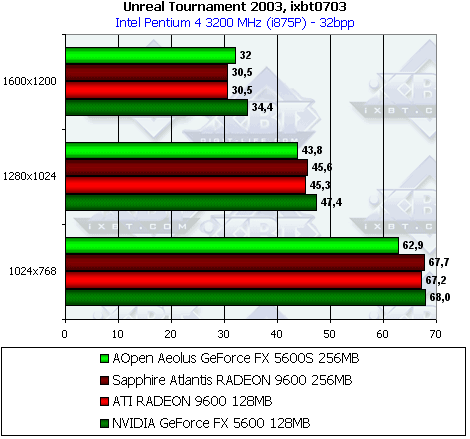
The picture is like in Serious Sam: TSE & RtCW.

The FX 5600 is smashed to pieces.
Well, this is an average card based on the FX 5600. I already mentioned before that such cards do not need extra 128 MB at all.
But from the standpoint of a unique product, this card has some interesting features. Overclcokers would be glad to have memory with the speed reserve, changeable voltages, a utility with the temperature control and warning LEDS.
This is a pleasant find for those who like experimenting and overclocking.
In our 3Digest
you can find full comparison characteristics for video cards of this and
other classes.
Write a comment below. No registration needed!
|
Article navigation: |
| blog comments powered by Disqus |
| Most Popular Reviews | More RSS |
 |
Comparing old, cheap solutions from AMD with new, budget offerings from Intel.
February 1, 2013 · Processor Roundups |
 |
Inno3D GeForce GTX 670 iChill, Inno3D GeForce GTX 660 Ti Graphics Cards A couple of mid-range adapters with original cooling systems.
January 30, 2013 · Video cards: NVIDIA GPUs |
 |
Creative Sound Blaster X-Fi Surround 5.1 An external X-Fi solution in tests.
September 9, 2008 · Sound Cards |
 |
The first worthwhile Piledriver CPU.
September 11, 2012 · Processors: AMD |
 |
Consumed Power, Energy Consumption: Ivy Bridge vs. Sandy Bridge Trying out the new method.
September 18, 2012 · Processors: Intel |
| Latest Reviews | More RSS |
 |
Retested all graphics cards with the new drivers.
Oct 18, 2013 · 3Digests
|
 |
Added new benchmarks: BioShock Infinite and Metro: Last Light.
Sep 06, 2013 · 3Digests
|
 |
Added the test results of NVIDIA GeForce GTX 760 and AMD Radeon HD 7730.
Aug 05, 2013 · 3Digests
|
 |
Gainward GeForce GTX 650 Ti BOOST 2GB Golden Sample Graphics Card An excellent hybrid of GeForce GTX 650 Ti and GeForce GTX 660.
Jun 24, 2013 · Video cards: NVIDIA GPUs
|
 |
Added the test results of NVIDIA GeForce GTX 770/780.
Jun 03, 2013 · 3Digests
|
| Latest News | More RSS |
Platform · Video · Multimedia · Mobile · Other || About us & Privacy policy · Twitter · Facebook
Copyright © Byrds Research & Publishing, Ltd., 1997–2011. All rights reserved.